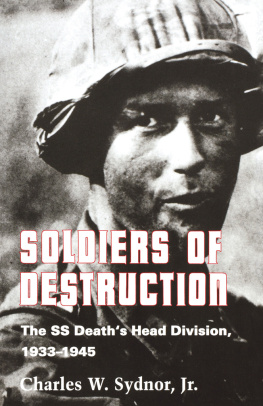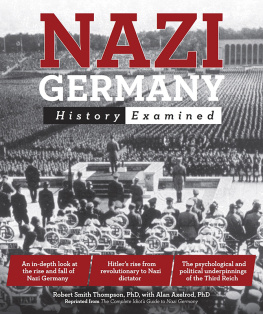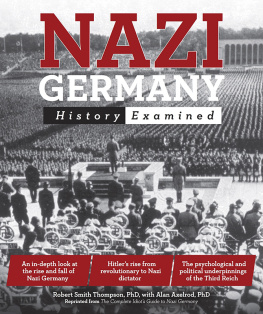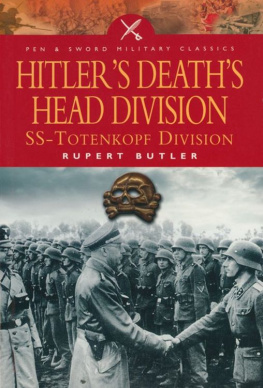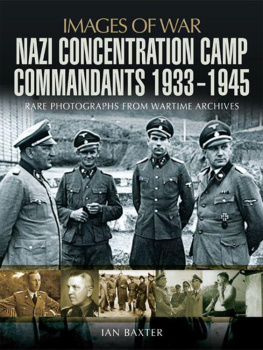Published by Princeton University Press,
41 William Street, Princeton, New Jersey 08540
In the United Kingdom, Princeton University Press, Chichester, West Sussex
Copyright 1977 by Princeton University Press
New preface and postscript 1990 by Princeton University Press
All Rights Reserved
Library of Congress Cataloging in Publication Data
Sydnor, Charles W.
Soldiers of destruction.
Bibliography: p.
Includes index.
1. World War, 1939-1945Division histories
GermanyWaffenschutzstaffel. 3. SS-Panzer-Division
Totenkopf. 2. Nationalsozialistische Deutsche
Arbeiter-Partei. Waffenschutzstaffel. 3. SS-Panzer-Division Totenkopf. 3. World War, 1939-1945CampaignsFrance. 4. World War, 1939-1945CampaignsRussia. 5. FranceHistoryGerman occupation, 1940-1945. 6. RussiaHistoryGerman occupation, 1941-1944. I. Title.
D757.85.S95 940.54'13'43 77-72138
ISBN 978-0-691-00853-0
eISBN: 978-0-691-21416-0
http://pup.princeton.edu
To the memory of my father,
Charles Wright Sydnor
(1920-1981),
Lieutenant Commander, United States Navy,
and
Captain, USS LCT 6-1303, Princess Pat,
the Marianas, the Philippines,
Okinawa
Like so many of his generation,
a lifelong casualty
of the Second World War
PREFACE TO THE 1990 EDITION
This book has had a remarkable life. As of now (November 1989), Soldiers of Destruction has been continuously in print for a longer period than the Third Reich survived. In normal circumstances of historical interest, or in a study of the more remote past, such published longevity might come only to a great and compelling work, conceived on a grand scale, and narrated with a sweep and analytical power embracing the many forces, events, and personalities that shape an age. The lifetime of most scholarly monographs is like that of the squirrel: four good seasons, and a dignified disappearance, after scattering an abundance of acorns that, with time, may or may not grow into giant oaks.
In that sense, this is a very ordinary book; unusual and compelling only because its subject occupied so central a place in the most extraordinary and destructive phenomenon ever to threaten the structure of civilization and the values of humankind. As a specialized monograph detailing the history and experience of a single Waffen SS division, the original edition of the book stimulated questions, provoked responses, animated inquiries and in time became caught up in the remarkable growth of public fascination with the Hitlerian era and the SS. In its own small way, Soldiers of Destruction helped to create the phenomenon that has now absorbed it.
By coincidence, Soldiers appeared about two years before a new explosion of trans-Atlantic interest in the history of Nazi Germany. During the last six years, in particular, the number of books, articles, scholarly controversiesand war crimes trialsfocusing upon the interrelated histories of the SS and the Holocaust have multiplied. This is because, institutionally, and for most of the history of the Third Reich, the SS Deaths Head Division occupied a strategic intersection amid the moving traffic of Hitlerian criminality. This central conclusion of my book, based upon the mass of archival evidence, is one of the attractions that drew substantial attention to the first edition.
Over the intervening thirteen years, this point has been confirmed, extended, enlarged upon, or documented even more graphically, in SS-related studies that have appeared on both sides of the Atlantic. Just as the experience of the SS Deaths Head Division reflected its remarkable range of destructive versatility and utility before and during the Second World War, so the recitation of its history continues to fascinate the casual reader, the serious student, and the experienced specialist alike. The story of the SS Deaths Head Division appeals to anyone who has an interest in some aspect of Nazi history or the unparalleled upheaval of the Second World War.
The readers of this edition, like those who examined the original, should know that the development of the volume, and the qualities and attributes that have made this book a historical monograph with its own history, are due much less to the literary gifts of the writer than to the editorial excellence of the publisher. In early 1975, Princeton University Press conditionally accepted the earliest version of this manuscriptat that time an almost hopelessly specialized Ph.D. dissertation, bristling with all the narrative qualities of a metropolitan telephone directory.
In the process of publication, three people, above all others, were responsible for the final form of the text that became the original edition of Soldiers of Destruction. They were: Miriam Brokaw, then the associate director of Princeton University Press, who sensed the importance of even so specialized a study in relation to the worlds growing interest in the history of the Hitlerian age; the late Professor Harold J. Gordon, Jr., whose painstaking review and exhaustive critique of the manuscript were summarized in a wealth of suggestions for improvement; and Robert E. Brown, the copyeditor originally assigned to the project by the Press. To Mr. Brown fell the formidable task of transforming a raw manuscript into a compelling and finished book. Over the months of editorial preparation, our long-distance collaboration grew into one of the most pleasant professional associations I have ever known. His patience never snapped; his enthusiasm never flagged; and his conviction in the value and importance of the work was boundless.
In matters of disagreement, I yielded invariably to his wisdomwith one exception, which now deserves confession in the record. Some of the juiciest archival material I had found, which had horrified even Heinrich Himmler at the time, Mr. Brown felt was too salacious and undignified to be included in so serious a work of history. I feigned acquiescence, and altered the textbut did manage to sneak the material back into the book in the footnotes.

